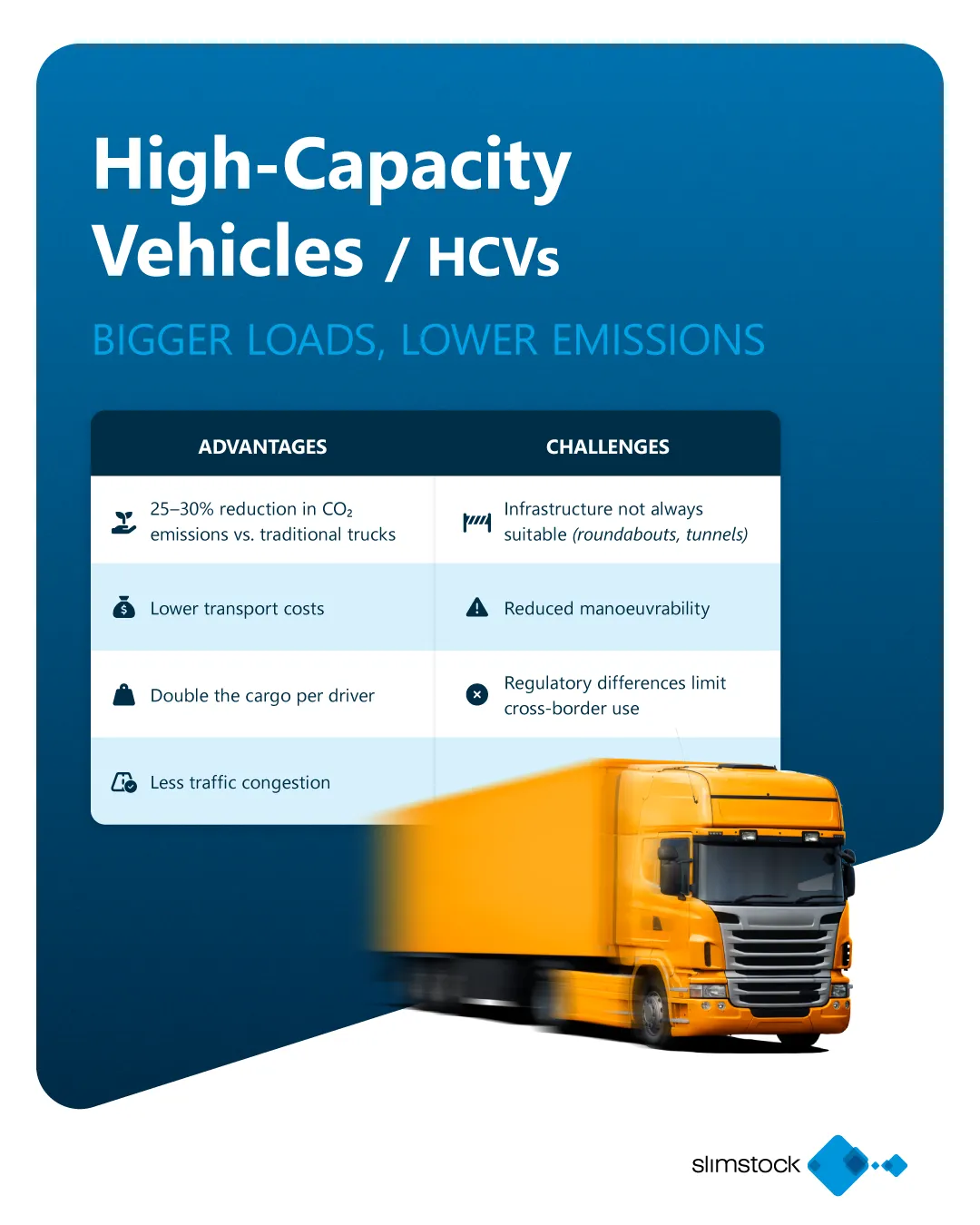Table of contents
Table of contents- High-Capacity Road Vehicles: comparing EMS configurations for efficient freight transport
- What is an EMS (European Modular System) vehicle?
- Advantages of High-Capacity Vehicles
- Disadvantages and challenges
- Operational restrictions
- Use cases: when do these vehicles make sense?
- Logistics planning: key considerations
- Future trends: platooning and smart convoys
- Conclusion: a long-term bet for logistics efficiency
Improving the efficiency and sustainability of freight transport has long been a priority for both public authorities and businesses worldwide. Efforts in this direction include fleet electrification, the development of alternative fuels, and route optimisation.
In recent years, a new type of road vehicle has emerged to meet these goals: High-Capacity Vehicles (HCVs), also referred to as Longer and Heavier Vehicles (LHVs) or European Modular Systems (EMS). These giant road freight combinations are designed to transport significantly more cargo per journey than conventional trucks.
In this article, we compare the two most prominent configurations trialled in parts of Europe: the 25.25-metre modular combination and the 32-metre double semi-trailer configuration. Known respectively in Spain as the megatrailer and the duotrailer, these vehicles offer insights into how large-capacity road transport can benefit supply chains globally.
What is an EMS (European Modular System) vehicle?
An EMS is a type of road freight vehicle configuration that can reach up to 25.25 metres in length and 60 tonnes in total weight (depending on the country’s regulations). This system connects standardised vehicle modules—such as a tractor unit, a semi-trailer, and a central axle module—to form longer, more efficient combinations.
In some countries, this configuration is commonly referred to as a Long Truck, LHV, or in Spain, a megatrailer (though elsewhere, this term may also refer to trailers with greater height rather than length).
What is the 32-metre combination?
The 32-metre configuration consists of a tractor unit towing two full-length semi-trailers, linked by a dolly. This setup is referred to in Spain as a duotrailer, though this term is not commonly used elsewhere in Europe.
With a total legal weight of up to 70 tonnes in pilot schemes, this configuration allows for even more cargo to be transported by a single driver, increasing efficiency where high-volume routes are consistent and predictable.
Technical requirements (may vary by country):
To operate such large vehicles, several technical and safety features are often required:
- A minimum engine power-to-weight ratio, especially for hilly terrain.
- Advanced safety systems such as:
- Electronic Stability Control (ESC).
- Lane Departure Warning.
- Emergency Braking Systems (EBS).
- Additional lighting or warning devices for visibility.
- A minimum number of axles with pneumatic suspension.
- Permits or route-specific authorisations issued by local road authorities.
Advantages of High-Capacity Vehicles
For companies that can make full use of them, these large vehicle configurations offer substantial benefits:
Emission reduction
High-Capacity Vehicles can significantly reduce the number of trips required to move goods, leading to 25–30% lower CO₂ emissions compared to conventional trucks.
Lower operating costs
More cargo per journey means savings in fuel, labour, tolls, and overall transport costs, making operations more competitive.
Increased driver productivity
A single driver can move twice the volume, helping alleviate the driver shortage that affects the logistics industry globally.
Less traffic congestion
Fewer trucks on the road carrying the same volume reduces road congestion and can contribute to lower accident rates in the long term.
Disadvantages and challenges
Infrastructure compatibility
Most road infrastructure was not built to accommodate 25–32 metre-long vehicles. Tight corners, tunnels, and roundabouts can pose major challenges.
Limited manoeuvrability
Their larger size reduces flexibility for urban or complex delivery routes.
Greater impact in case of accidents
While accident frequency may decrease, the severity of accidents involving heavier vehicles can be greater due to increased momentum.
Regulatory fragmentation
Different countries have different legal frameworks for these vehicles. Cross-border transport is currently limited unless harmonised agreements are in place.
Operational restrictions
In most regions, EMS or HCVs are permitted only under specific conditions:
- Restricted routes with suitable infrastructure.
- Prohibition during adverse weather (e.g. strong winds, low visibility).
- Speed limits often lower than for conventional trucks.
- Special authorisation or permits are usually required for operation.
- Some countries or regions may prohibit the use of HCVs entirely.
Use cases: when do these vehicles make sense?
Due to their complexity and required planning, HCVs are generally used for:
- Fixed routes between a single origin and destination.
- High-volume flows, often over distances greater than 150 km.
- Industries with daily, predictable demand, such as:
- Automotive manufacturing (especially Tier 1 suppliers).
- Food and beverage distribution to large retail chains or platforms.
Logistics planning: key considerations
Using HCVs requires precise coordination by transport planners or traffic managers. Key questions include:
- Can I consistently fill the entire truckload?
- How many additional stock days am I absorbing by doing so?
- Will this result in excess inventory and associated costs?
Some suppliers may insist on full truckload orders to optimise their own operations. This can be difficult to manage with such high-capacity vehicles, especially if demand fluctuates throughout the year.
Tip:
Avoiding supply shortages is crucial for customer satisfaction and sales. Selecting the right suppliers is key—check out our guide to supplier relationship management.
Future trends: platooning and smart convoys
Another promising development is platooning, where trucks travel in closely spaced convoys using vehicle-to-vehicle communication. This reduces air drag and can result in up to 15% fuel savings, particularly when combined with HCVs.
Conclusion: a long-term bet for logistics efficiency
EMS and other high-capacity vehicle combinations offer meaningful solutions to today’s logistics challenges. They can:
- Reduce emissions
- Improve cost-efficiency
- Help mitigate the driver shortage
- Support larger-scale supply chain strategies
While current use is still limited to specific sectors and routes, the expansion of regulatory frameworks and infrastructure upgrades are expected to make these vehicles a permanent fixture in international logistics in the coming years.







